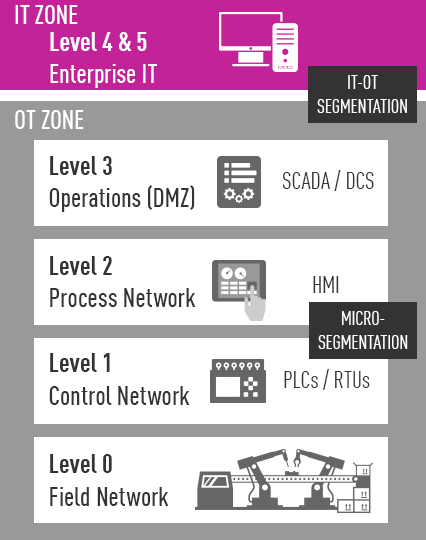The Difference between IT and OT
Operational technology systems use many of the same tools as IT environments, but are designed to be used in different ways. Instead of operating primarily as a tool for the human, OT devices mostly interact with other machines, such as industrial control systems (ICS). Their purpose is to ensure that the ICS assets are operating correctly and meet the high availability and uptime requirements of these devices.

IT and OT Convergence
Historically, IT and OT networks have been separate. OT systems often run legacy software, making them more vulnerable to compromise, and an intrusion can render them unable to meet their production high availability requirements. For this reason, OT systems, while connected to a network, were “air gapped” from IT networks and the public Internet.
With the introduction of the IIoT, the IT/OT air gap is rapidly dissolving. IIoT devices enable industrial processes to be remotely monitored and managed from a central location, allowing organizations to achieve greater efficiency and productivity. However, this comes at the cost of bridging the physical network disconnect that protected these legacy systems from cyber threats. As a result, OT environments now require specialized OT and IoT security solutions.
What is Operational Technology Security?
While OT devices use many of the same systems and software as IT machines, they are used in very different ways and often operate under different expectations.
These different operating conditions impact the security of these systems. For example, OT’s high availability requirements make it difficult to take down systems for updates and malware remediation. Popular opinion is that it is more important for a system to run continuously than it is for it to be entirely secure. For this reason, these systems are prone to targeted attacks and malware infections.
Operational technology (OT) security is designed to meet the unique security needs of OT environments. This includes protecting system availability, understanding OT-specific protocols, and blocking attacks targeting the legacy systems commonly used in OT environments.
Operational Technology (OT) Security Best Practices
Operational technology environments often lag behind their IT counterparts in terms of security. Securing these OT environments and systems against cyber threats requires implementing OT security best practices.
Operational technology networks can be complex, and many organizations lack full visibility into their OT resources. This problem is complicated by the fact that an OT network may be spread out over multiple factories or geographic sites.
Effectively protecting operational technology networks requires complete visibility into the assets connected to these networks making OT device discovery a necessary first step in an OT security strategy.
Historically, operational technology networks were protected by an air gap, where IT and OT networks were physically disconnected from one another. While this does not provide perfect protection against cyber threats, it made vulnerable OT assets more difficult for an attacker to access and exploit.
As IT and OT networks converge, organizations must replace the air gap to protect legacy systems that were never designed to be connected to the Internet. Network segmentation allows isolation of assets within the network, and a firewall with knowledge of OT-specific protocols can inspect traffic for potentially malicious content or commands and enforce access controls across OT network segment boundaries.
Operational technology cybersecurity strategies are often detection-focused due to the potential for false positive errors in threat prevention tools. If a legitimate operation is incorrectly labeled and blocked as malicious, then it could impact the availability and performance of the system. As a result, OT security was often reactive with attacks and infections remediated when convenient.
This approach to security results in OT systems that are infected with malware that threatens their operation. Additionally, many types of attacks can be detected and blocked with extremely high precision, posing a minimal threat to normal operations. By deploying operational technology threat prevention, an organization can better secure their OT assets in a time where these systems are increasingly targeted by cyber threat actors.
Securing OT with Check Point Software Technologies
OT systems and networks are very different from their IT counterparts – they may use some of the same hardware, yet the software, protocols, and expectations differ greatly between OT and IT.
Effectively protecting OT systems against cyber threats requires cybersecurity solutions with a deep understanding of OT environments. To learn more about Check Point’s OT-specific threat management solutions, check out this solution brief. You’re also welcome to see how these solutions work for yourself by signing up for a free demo.



















